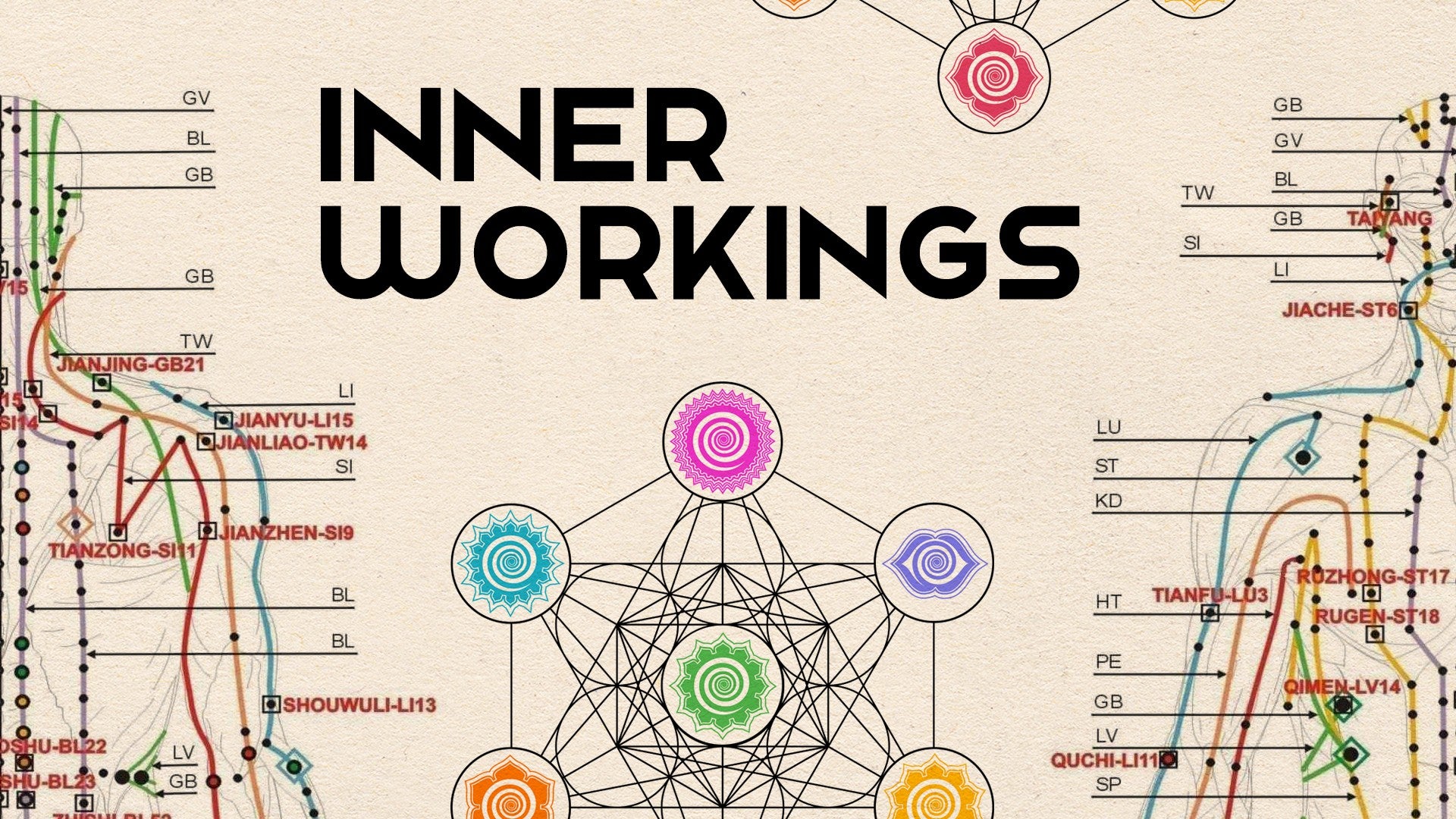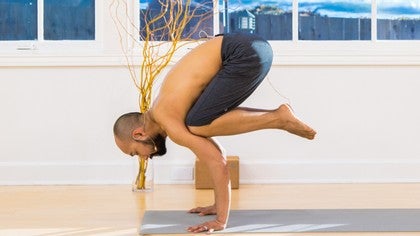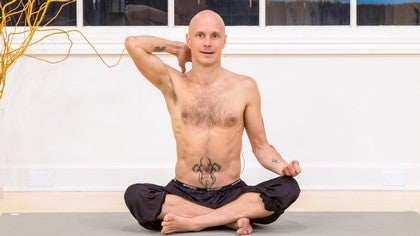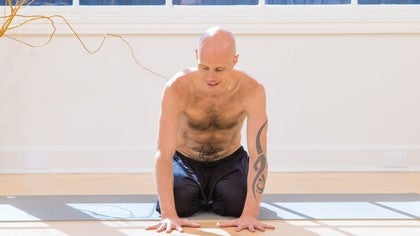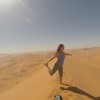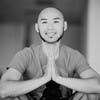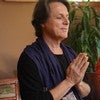Description
Transcript
Read Full Transcript
Salutations. So here we begin the All Levels Vinyasa class, appropriate for beginners and intermediate advance. I'll demonstrate some of the more challenging transitions. So here we go. Let's get started.
We'll start with the Gayatri Mantra. What it means is may the light of knowledge protect and guide us along the path. Find a nice tall seat. Bring the hands to prayer. And we'll begin with one Om.
Inhale deeply. Om. Om Bhur Bhuva Swaha. Tat Savitur Varenyam. Bhargo Devasi Adhi Mahi.
Dio Yona Prachodaya Ate. Om Bhur Bhuva Swaha. Tat Savitur Varenyam. Bhargo Devasi Adhi Mahi. Dio Yona Prachodaya Ate.
Om Bhur Bhuva Swaha. Tat Savitur Varenyam. Bhargo Devasi Adhi Mahi. Dio Yona Prachodaya Ate. Om.
Shanti. Shanti. Shanti. Let us begin. From a seated position, we'll meet back in downward facing dog.
You may press up, jump back, or crawl back. Downward facing dog. From the downward facing dog position, let's take five breaths here. Press through your hands, spread your fingers, press the pads of your hands into the ground. Straighten the elbows and push your hips back, draw the navel in.
Engage the front of your legs. Keep breathing. Pull the knees up and relax the heels towards the floor. Keep pushing through the hands. Four, that should be about four breaths if they're pretty quick.
From the downward facing dog position, exhale and hold your breath out and bend the knees. Look between the hands and either lightly step or jump your feet between the hands. Inhale and half lift. Exhale, lower the head down. Inhale, come all the way up, reach up, look up, keep stretching.
Gazing past the thumbs, maybe the palms touch. Exhale, release the arms. Middle fingers on the IT band, shoulders back. Inhale, raise the arms up, look up, palms touch. Draw the navel in, exhale, push your hips back and bend forward, hands next to your feet.
Inhale, half lift. Press your hands into the floor and step or jump back high to low, chaturanga dandasana. Inhale, upward dog. Exhale, downward dog. Breathe.
Press through the hands, flex your legs, lift your toes, heels down. Knees are moving up towards your hips, gazes towards the navel or past your knees. Jalandhar bandha, mula bandha. Four. Five.
Bend the knees, exhale, look between the hands and lightly step or jump up, feet between the hands. Inhale, half lift. Exhale, head down. Inhale, arms up, reach up, look up, keep stretching. Gazing past your thumbs, exhale, release the arms by your side.
Feet together. Bend the knees, maybe fingertips or palms to the floor, keep the heels on the ground. Inhale, chair pose. Look up, touch the palms together and exhale, fold, chest to thigh, maybe straighten the legs. Inhale, half lift.
Press your hands and step or jump, chaturanga. Inhale, upward dog. Exhale, forward and up. Exhale, downward dog. Immediately, left heel down, 45 degrees, right foot forward between the hands.
Inhale, raise the arms up. Stretch your left hip flexor. Exhale, chaturanga, hands down, right foot back, lower as you exhale. Inhale, upward dog. Exhale, downward dog.
Lift your hips back. Right heel down, 45 degrees, your back foot. Forward, inhale, the arms up, warrior one. Stretch that right hip flexor. Exhale, back down, chaturanga dandasana.
Inhale, upward dog, urdvamukha. Exhale, push your hips back, draw the navel in, gaze, navel or past your knees and breathe. Bandhas. Ujjayi. Do.
Press your palms flat. Three. Don't hold your breath. Four, remember this is a breathing exercise. Hatha yoga is pranayama.
Four, push your hips back. And five, inhale, step or jump up. Feet between the hands and exhale, lower the head down. Bend your knees, inhale, stretch the arms up, reach up, look up, palms touch. Exhale, straighten the legs and release the arms.
Inhale, bend the knees, raise the arms up. To your degree, exhale, fold, chest to thigh, hands next to the feet. Inhale, half lift, draw the navel in, chaturanga, step or jump. Lower down, inhale, upward dog. Exhale, downward dog.
From the down dog position, inhale, lift the right leg up. Exhale, place the right foot between the hands and spin your back foot flat. For warrior one, inhale, stretch the arms up. Exhale, interlace the fingers behind your back. Humble warrior, inhale, stretch and look up, pull the arms back, open the heart.
Exhale, humble warrior, head to ankle, and breathe. Stretch your shoulders. Inhale, lift your head up, and fallen tree, you're going to lift the left leg up, keep your gaze forward, lift the arms and lift the left leg. Maintain your balance and your breath. Lower the arms, inhale, warrior one, bend your right knee and step the left foot back, arms up.
Exhale, open to warrior two, widen your stance a little bit. Lengthen your stance, take up some space on your mat. Arms are in line with your legs, the right knee's bent up to 90 degrees. Keeping the back leg strong, the back foot's about 90 degrees as well. Inhale, straighten the right leg, prepare for triangle pose.
You may toe heel the back foot up or keep it long. Reach and exhale, slide down the right leg. You may use a block underneath the right arm or place the hand on the floor. If you do it the ishtanga way, you might have a shorter stance and catch the big toe. You may gaze at the left thumb or down.
Then look down for half moon. You're going to look forward about a foot. Come onto the fingertips and lift your left leg. The thumb is in line with the pinky toe, about a foot in front, or you may use a block. Raise your left arm, lift your left hip, lift your left leg.
Left pinky toe points towards the ceiling so you get an external rotation in the left leg. Take a few breaths. Remember to pull the navel in to support the spine. If it's available, you may take your gaze to the left thumb. Keep breathing.
Even if you start to lose your balance, get back into the pose and breathe. If looking up is not available today, let it go and look down. If it's available, you want to bend your left knee for chapasana, catch your left foot. I'm going to look down because this is where I'm at today. You're going to kick into the left hand, stretching that left hip flexor.
If this is not available, go back to half moon. Release your left leg, stretch the left arm up, and then bend your right knee. Gently place your left foot back. Inhale, reverse your warrior. Raise the right arm up past your ear.
You can slide the left hand down your left leg or take the left hand behind your back. Place both hands down, framing the right foot. You may take crow pose or just meet back and downward facing dog, or you may press up into handstand. And we'll meet all meet back and downward facing dog. And we're ready for the second side.
Inhale, lift the left leg up. And exhale, place the left foot between the hands. Warrior one, back foot flat. Inhale, raise the arms up. Interlace the fingers behind the back.
Exhale, pull the shoulders back, straighten the arms. Inhale, open your heart. Humble warrior, exhale, head to ankle. Make sure the left shoulder is inside the left knee. If you're modifying, it's okay to keep the shoulder above the knee, but eventually the head will come towards the floor next to the ankle.
From here, fallen tree, lift your head, gaze forward, and balance on your left leg, lift your right leg up. Keep lifting the arms. Lift the right leg. Gaze forward, breathe, balancing. And lower the arms.
Warrior one, inhale, back foot flat. Warrior two, exhale. So widen your stance. Back foot's about 90 degrees. Left knee's about 90 degrees.
Arms are in line with your legs. Your spine is vertical, shoulders above the hips. Inhale, straighten the left leg for triangle pose. Again, if you did on the other side of shorter stance, you may toe heel your right foot up. And exhale, go down to your degree, maybe resting your hand on a block or shin, or catching the toe if it's available, or just the left hand on the floor.
It's okay as well. Gazing up, the right thumb if available. Your ribs should be right over your left thigh. Upper body over the left leg. Inhale, and bend your left knee, half moon.
Slide the left hand forward either on a block or fingertips to the floor. The left thumb is in line with the left pinky. The right arm overhead. Right leg lifting, pinky toe towards the ceiling. So it's an external rotation in the right hip.
Stacking the shoulders, stacking the hips. Then back to warrior two. To reverse your warrior, bend your left knee. Gently place the right foot back. Inhale, stretch the left arm overhead.
The right hand can slide down the back of the right leg, or place the right hand behind your back. Exhale, and frame the left foot with both hands. You can meet back in downward facing dog or take your arm balance. And vinyasa. And from the downward facing dog position, step or jump through to a seated position.
Bend your knees, look three feet in front, and step or jump through. Ardhamatsyandrasna, lord of the fish, half lord of the fish. We're going to take the left foot, bend your left knee, place the left foot by your right hip, and instead take the right foot across your left knee. So the right ankle is near your left knee. Sit up tall, inhale.
Exhale, twist to the right. You can take your left elbow outside the right knee. You can bind by threading. Or you can take your right knee outside of your left armpit and reach and catch your big toe or your foot. Your hand can come back around and catch your left thigh.
The gaze is over the right shoulder. Look forward and release. You can take a vinyasa by pressing the hands into the floor and jumping back, crawling back. We'll meet back in a seated position. If you like to press up, press your hands into the floor, pull the belly in, lift your hips up, jump back.
Inhale, upward dog. And exhale, downward dog. Look three feet in front, lightly step or jump through and sit down. The other side. Bend the right knee.
Bring your right foot near your left hip. Take the left foot next to the right knee. Sit up nice and tall, exhale and twist. Take the elbow, your elbow across, left hand supports behind you. You may bind by threading, looking over the left shoulder or taking your left knee outside of your right shoulder, catching your big toe or foot.
Left hand back, deep twist. One, two, breathing. Three, four and five. Look forward to release. Take your vinyasa, meet back in downward facing dog.
Take a few breaths. Remember your bandhas, mula bandha, jalandhar bandha, chin to chest, gaze towards the navel or past your knees. Pull the pelvic floor up. Engage your legs, engage your arms, breathe. And lightly place your knees between the hands.
From here, take your back bend. So beginners, just place your hands on your low back and push your hips down. You can be on your toes or you can place the tops of the feet down. And just simply look up. And so what you're looking for is a stretch either in the throat, the chest, the abs, the hip flexors, the thighs.
If you need padding, you can take your mat and double up if you need extra padding. Now keep pushing your chest into the ceiling or the sky. And your hips forward. If it's available, you can catch your feet, your ankles or your feet or heels. Open your chest more.
Lift your chest up. So don't collapse. If it hurts, come on out, place your hands on your back and look up or take child's pose. But if you want to go a little deeper, lift your chest up, pull your shoulders back. Maybe you can see the lift here.
A lot of engagement. Pull the thighs inward. There's an internal rotation in the hips. Keep pushing the hips forward. And release the child's pose.
Watch your breath. If you need to, you can self-massage on your low back using the hands on your low back. Stay with your breath. You may repeat that. Those of you ready for drop backs, or if dropping back is in your practice, you may come to standing.
Feet apart, hips distance. Or a little wider. So a standing back bend, you may just look up. If you're a beginner, please do not attempt this. But if you've been doing this a little while, you may start to lift your chest up and look back.
Only go slowly. Start to push your hips forward and lift your chest up and back, getting a stretch in the front side body. Maybe that's as far as you go. Now, if you can see the floor behind you, a little bend in the knees, maybe you can see the floor in the back of your mat. If you can see the floor, maybe reach your arms, bend the knees and slowly lower the hands to the floor.
And push through the arms, push your hips up, breathe. Now, to come back up, you bring weight into the feet, into the knees, use your legs, really strong legs. And push your hips forward and lift your chest up. And then the head comes up last. And then everyone, forward bending the top of your mat.
Paschimottanasana. Knees can bend, head down. And you straighten your legs to your degree. Five breaths. And keep the knees bent if you feel any pain in the low back.
And five. Inhale to come up. At this point, we'll take our inversions. You may take the shoulder stand or the head stand position. So with the shoulder stand, starting on your back, legs together, hands by your side, press the elbows into the floor, bend your elbows 90 degrees, press the elbows into the floor. As you exhale, lift your legs first, then your hips.
And place the hands on your back. Walk the hands close to your shoulder blades to your degree and extend the legs towards the ceiling. You remain there. If you're doing headstand, come out of the pose. If you're doing headstand, starting on your knees, supported headstand, not tripod, hands cross the arms, place the elbows on the ground, cross the arms and catch both elbows with opposite hands.
Interlace the fingers, tuck the bottom pinky underneath, place the head between your wrists, squeeze the head gently, keep the elbows squeezing inward, and lift the knees, walk it up, draw the belly in, try not to kick into your headstand and then bring the legs up slowly, stacking your bones, and breathe. Find your center, find your breath. Keep the legs together, big toes touch, with the big balls of your feet touching. If you're in shoulder stand and you need to come out at any time, feel free to come out and go back in. Now as you advance your practice, your headstand practice, your breath will start to slow down, not speed up.
So if you notice your breath speeding up here, you're probably almost done. But if you can relax in the pose, your breath will get longer. Like so. If you're in shoulder stand, go ahead and lower your legs slowly for halasana. If you're in headstand still, push your hips back and lower your legs halfway, parallel to the floor. As soon as you see the toes or your feet lower them, just another couple inches or so, so they're parallel to the floor.
And breathe. Okay, and if you're in shoulder stand or plow pose, lower the knees next to the ears. If you're in headstand, take the legs back up if you're still with me. Stack your hips above your shoulders, knees and ankles above your hips. Find your center. This is samastitihi on your head.
If you're still in headstand, lower slowly, hover your toes an inch off the ground. Push your hips back, counterbalancing. There should be no struggle. And lower down to child's pose. If you're coming out of karnapidasana ear pressure pose or halasana, the plow pose, slowly lower your hips, hands on the floor behind you, one vertebra at a time.
And you'll take matsyasana or fish pose, so I'll demonstrate the matsyasana or fish pose. The full position is actually done in lotus. If you have the lotus, you can take it. If not, keep the legs straight. Don't force the lotus ever.
Yoga is fun, but walking is more fun. Catch your feet, pull and lift your head up or chest up. And if you look at this pose from the top, it looks a lot like a fish, matsyasana fish pose. If your legs are straight, you can place the hands underneath the hips, engaging your biceps to take the back bend. And if your low back feels okay here, you may lift your legs, hands in prayer, above your navel.
And lower down, release the pose. If you're not on your back, come onto your back, cross your ankles, catch your feet, and let's rock and roll a little bit. Rock and roll on your spine. It helps to exhale on the way back. If you can, roll in a circle.
It feels nice on your back. If your spine is protruding, try to roll around your spine. And then you want to work the brain in the opposite direction. Self-care is a new health care, taking care of our spine. And from here, we'll meet back in seated position.
You may just roll up and sit or take your vinyasa. And step or jump through and sit down. So here we'll do some pranayama. Find a comfortable seat. If lotus is comfortable, take it.
If it's not comfortable, don't take it. Find a comfortable seat. You can also sit in hero. You can sit on a block. The important thing here, you guys, is to have your spine straight.
So whatever you need to do to keep the head, neck, and trunk in line. Remember, the most important things in yoga are invisible. Yoga is not about what you can do, but the quality you do something with. So with your head, neck, and trunk in line, inhale. Exhale.
You can begin to close your eyes if you like. Inhale, try to stay with me. And exhale. Inhale. Keep inhaling as much as you can.
Draw the navel in and expand the ribs. And then exhale, keeping the bundas active. Now inhale. And then exhale through the left side. Close your right nostril with your right thumb.
Inhale left. Exhale right, closing the left nostril with the ring finger. Exhale until you can't exhale anymore. Inhale right. And exhale left.
Try to equalize the length of your breath. Inhales and exhales are equal in length here, if you can. Inhale left. Exhale right. Continue with that pattern.
Inhale right, on your own. So, Hatha Yoga is Pranayama. My teacher would always say that. Inhale left. And exhale right.
In right. Out left. In right. Out both. In both.
Out both. Now let's take five more breaths without sound. In. Out. In.
Feel the coolness on the top of your lips, the nostrils. Out, feel the warmth as you exhale. Slowly, quietly. Just notice the subtlety, the subtleness of your breath. In, slowly, feel the coolness.
It's about two degrees cooler. Slowly exhale, two degrees warmer. Slowly. Stay with your breath. Subtle breathing.
Two more breaths. Slowly inhale. Slowly exhale. Last one. Slowly inhale.
Slowly exhale. Don't forget your Mula Bandha. Keep your eyes closed. You may stay seated. The right hand on top of the left, below your navel, where the hands can be in Gyanamudra.
The back of the wrists on the knees, head, neck, and trunk in line, where you may lay down and take Shavasana. Stay with your breath. Shanti. T.S. Eliot in his poem, The Wasteland, describes Shanti as a peace that passeth understanding. Yoga is Shanti, the peace, the silence between your thoughts.
The reason it's not understandable is because you don't use your mind to understand Shanti. Shanti is something that you experience. Quietude. Chittavrittini rota, the space between your thoughts. Stay with your breath.
Peace in. Shanti in. Shanti out. You may stay here a little longer if you like, or if you're ready to sit up, wiggle your fingers and toes, and we'll meet back in a seated position with your head, neck, and trunk in line. And from the seated position, we'll meet with the hands in prayer.
We'll close with the peace mantra. May all beings in all places be happy and free. Please repeat, loka, loka, samasta, samasta, sukino, sukino, pavantu, pavantu, uchan om, and loka, samasta, sukino, vavantu three times, and then om, shanti, shanti, shanti. Big breath in for om. Om.
Loka, samasta, sukino, pavantu, loka, samasta, sukino, pavantu, loka, samasta, sukino, vavantu, om. Shanti, shanti, shanti. Om Shri Guru Pyaanama Harihi Om. Salutations. Namaste.
Inner Workings: Jani Jaatinen & Ricky Tran
Comments
You need to be a subscriber to post a comment.
Please Log In or Create an Account to start your free trial.
